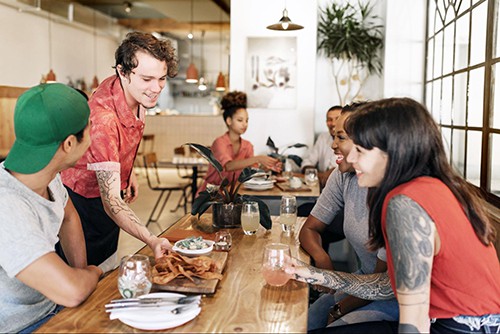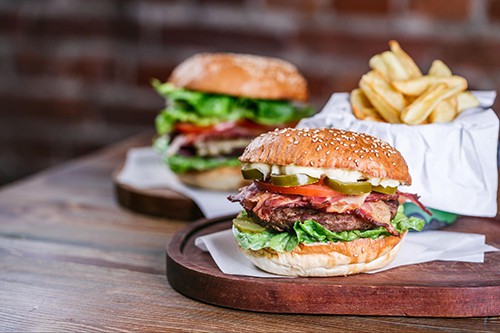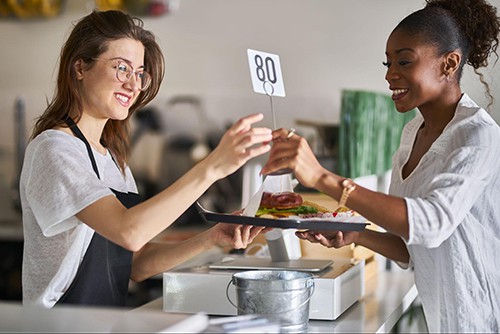The 14 Best Mobile Time Clock Apps in 2024
Get an accurate picture of work hours and labor costs with an app. We’ve creat...

Curious about what’s going on “under the hood” of your restaurant and want to make your business more profitable? Learn how to use restaurant ratios.
In this article, we discuss some of the key performance indicators that all restaurant managers should know, how to calculate these important restaurant ratios, and what to do with the numbers when you’re done.

Restaurant ratios are key performance indicators (KPIs) that provide insight into everything from profit and loss to average customer spending and menu item profitability.
That said, some of these numbers may be more important than others for the successful — and profitable — operation of your business.
For example, Customer Acquisition Cost (or CAC) can help you see how much it costs to get a new customer in the door. But CAC may be less important than what might be considered the more fundamental restaurant ratios such as prime cost, labor cost, and cost of goods sold.
If you’re not controlling restaurant spending with the latter three KPIs, customer acquisition cost may not be useful in helping you fine-tune the way your business runs.
That’s not to say that CAC isn’t important — it may be. But it might only really be useful after you’ve already got some of the more fundamental KPIs under control.
In addition to the restaurant ratios discussed in this article, you may also be able to make use of other metrics to keep your business on the road to success.

To calculate cost of goods sold (CoGS) percentage, you’ll need to first tally the value of your inventory, the value of any new inventory purchased, and the value of your ending inventory.
Plug those numbers into the following formula to find out the total cost of everything that you sell to your customers.
CoGS = (Beginning Inventory + Purchased Inventory) – Ending Inventory
So, for example, if your restaurant had $2,000 in leftover inventory from last month (i.e., your beginning inventory for this month), you purchased $9,000 worth of ingredients, and you ended the month with $1,000 inventory leftover, your equation would look like this:
CoGS = (Beginning Inventory + Purchased Inventory) – Ending Inventory
CoGS = ($2,000 + $9,000) – $1,000
CoGS = $11,000 – $1,000
CoGS = $10,000
Once you’ve calculated your CoGS, you can divide that number by the total sales for the same time period to get a snapshot of your restaurant’s financial health.
To calculate restaurant labor cost, you’ll need two pieces of information: total income and total labor costs.
To find total income, print off a yearly sales report from your POS software. To find total labor costs, add up everything that has to do with your restaurant’s employees, including:
Then, plug those numbers into the following equation:
Labor Cost Percentage = Total Labor Cost / Total Income
So, let’s say your restaurant made $42,000 last month while spending $12,500 in labor costs. Here’s what the labor cost percentage would be.
Labor Cost Percentage = (Total Labor Cost / Total Income) x 100
Labor Cost Percentage = ($12,500 / $42,000) x 100
Labor Cost Percentage = 0.297 x 100
Labor Cost Percentage = 29.7%
For more information on labor cost and how it applies to your restaurant ratios, check out these articles from the Sling blog:

To calculate your restaurant’s food cost percentage, you’ll need two pieces of information: your restaurant’s CoGS for a specific period of time and its total food sales (or total income) for that same time period.
Then, use the following equation to figure out this entry on the list of restaurant ratios:
Food Cost Percentage = CoGS / Total Income
Since we calculated CoGS and Total Food Sales (a.k.a. Total Income) for a month in ratios one and two, we’ll use those numbers in this example.
Food Cost Percentage = (CoGS / Total Income) x 100
Food Cost Percentage = ($10,000 / $42,000) x 100
Food Cost Percentage = 0.238 x 100
Food Cost Percentage = 24%
For more information on this important metric, check out this article from the Sling blog: Food Cost Percentage: Definition, Calculation, And Optimization.
Prime cost restaurant ratios give you insight into your two largest costs: food and labor.
To calculate this KPI, you’ll need your restaurant’s CoGS, its Total Labor Cost, and its Total Income for a specific period of time. We’ve calculated a month’s worth for all three already, so we’ll use those numbers along with the following formula:
Prime Cost Percentage = ((CoGS + Total Labor Cost) / Total Income) x 100
Prime Cost Percentage = (($10,000 + $12,500) / $42,000) x 100
Prime Cost Percentage = ($22,500 / $42,000) x 100
Prime Cost Percentage = 0.535 x 100
Prime Cost Percentage = 54%
Restaurants can try to keep their Prime Cost Percentage around 60%. Higher than that, and your costs could be too high. Lower than that, and you may be using low-quality ingredients or working your team too hard.
Learn why prime cost percentage matters for your restaurant in this article from the Sling blog: Prime Cost: Why It Matters For Your Restaurant And How To Calculate It.
To figure out your overhead restaurant ratios, start by adding up all the fixed costs you spend in a specific period of time (e.g., one month).
For example, let’s say that you spend:
Your total fixed costs would be $9,000. With that number, your Total Income for the month, and the total number of hours you were open, you can calculate your overhead percentage and your overhead rate.
Here’s the formula for calculating overhead percentage:
Overhead Percentage = (Overhead Costs / Total Income) x 100
Using the numbers we’ve already established in this article, here’s how everything would work.
Overhead Percentage = (Overhead Costs / Total Income) x 100
Overhead Percentage = ($9,000 / $42,000) x 100
Overhead Percentage = 0.21 x 100
Overhead Percentage = 21%
So, for every dollar you brought in that month, you spent $0.21. That’s not bad, but the lower your overhead percentage, the higher your profits.
Your restaurant’s overhead rate is kind of like an employee’s hourly rate. Here’s the formula:
Overhead Rate = Overhead Costs / Total Number Of Hours Open
For this example, let’s say your restaurant was open for a total of 340 hours during a single month. Your overhead rate would be:
Overhead Rate = Overhead Costs / Total Number Of Hours Open
Overhead Rate = $9,000 / 340
Overhead Rate = $26.47
That means that you’re spending $26.47 per hour on your overhead costs each month.
For more advanced ways to calculate and manipulate your fixed costs, take a few minutes to read this article from the Sling blog: How To Calculate Overhead Costs In 3 Easy Steps.

Labor costs may be one of the largest expenses your restaurant will face in the course of business. As such, the labor cost restaurant ratios are some of the most important KPIs to get a handle on.
Sling can help.
The Sling app’s labor costs feature gives you the ability to set wages per employee or position and see how much each shift is going to cost as you schedule (and before making everything final) to help you keep your restaurant spending under control.
Sling can also help you keep track of your labor budget and can be set to alert you when you’re on track to exceed the labor cost restaurant ratios you’ve set.
Sling can even notify you when you’re about to schedule someone into overtime so that you can make the necessary changes.
For more free resources to help you manage your business better, organize and schedule your team, and track and calculate labor costs, visit GetSling.com today.
See Here For Last Updated Dates: Link
This content is for informational purposes and is not intended as legal, tax, HR, or any other professional advice. Please contact an attorney or other professional for specific advice.
Schedule faster, communicate better, get things done.